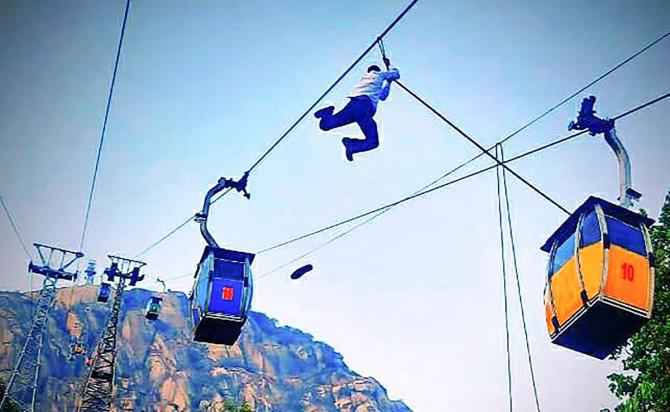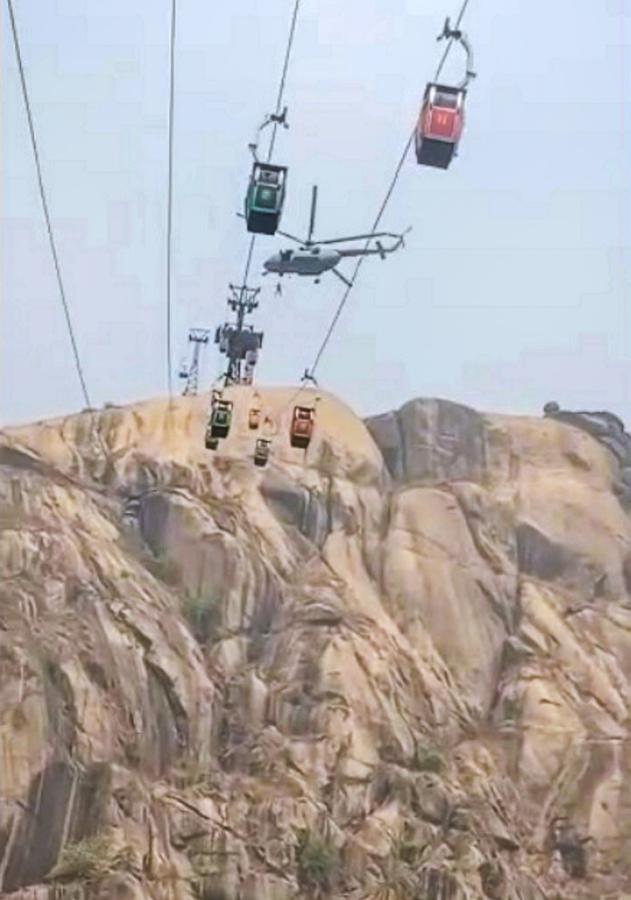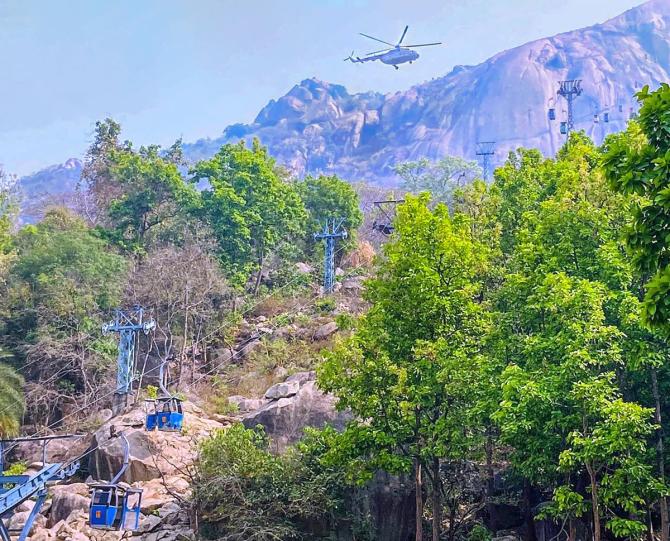'Imagine hanging from a thin steel cable under a helicopter with certain death staring at you below, being pulled up slowly in the din and downwash of the helicopter.'
IAF Veteran Air Commodore Nitin Sathe, a helicopter pilot himself, reports on how the air force rescued those trapped in the Deoghar cable cars disaster last fortnight.

Respected Sir,
Subject: Request for help in rescuing tourists stuck in Trikut Hills Ropeway Service incident, Deoghar District, Jharkhand State
Today around 430pm, one trolley in the Ropeway service got dislodged from pulley. Because of this, the Ropeway service got stopped.
15 persons got rescued by the local guides and NDRF team. 3 people grievously injured admitted in Sadar Hospital.
Around 40 tourists are still stuck in the Ropeway in 10 trolleys at the height in the hills. Local NDRF team is not able to rescue them.
Need help in evacuation of these tourists stuck in the trolley in the hills.
Local NDRF team commander - Name: @@@@@@, Mob-xxxxxxxxxx
Bn Comdt, based in Patna : Name : @@@@@@, Mob-xxxxxxxxxx
Thanks & regards,
Manjunath Bhajantri, IAS
District Magistrate, Deoghar
Jharkhand State
Mobile: xxxxxxxxxx
This was the message received from Mr Manjunath Bhajantri, the DM of Deoghar on the night of the 10th April, which set into motion one of the daring rescues by helicopters of the Indian Air Force.
An officer involved with the rescue tells me what happened after the IAF received this message:
"It was 1030 at night and we had just celebrated my son's birthday and were getting our house back in order when the telephone rang. With the news, I rushed to my flight commander's residence to discuss what all we needed to do.
"He was in the middle of dinner and we got talking at the dinner table.
"The aircraft had to be made ready, we needed to carry spare winch cables, rescue strops and batteries and everything else that would keep us self-sufficient to operate from the new place for the next few days.
"While the technical crew and the co-pilots got ready doing their things, we researched the Internet for information on the place, the cable car and whatever details we could find.
"One thing was clear, it had to be a winching operation, there was nothing else that our chopper could do to get those pilgrims down from where they were stuck.
"This kind of mission requires special skills, experience and risk taking abilities. We decided that it had to be one of us to lead the way.
"After much deliberation, it was I who decided to go while my deputy would stay back at base to carry out all the tie-ups and liaison to ensure that we complete this task professionally.
"He insisted that I get adequate rest since the next day would be long and taxing.
"In the adrenalin rush that followed, punctuated by many calls through the night giving me updates and instructions, I could barely sleep a wink that night.
"And when I did get my forty winks, in my sub-conscience, thoughts about how, what when and where kept going through my mind."

On the evening of April 10, 2022 the nation was alerted about the cable car accident on the 766 metre-long Trikut ropeway at Deoghar in Jharkhand.
At about 1630 hours, two cable cars collided and fell to the ground due to a malfunction, and the entire ropeway of 20 cars, carrying about 70 pilgrims came to a grinding halt, putting the lives of those on board hanging in the balance.
National Disaster Response Force and State Disaster Response Force, teams pressed into service, managed to rescue 14 pilgrims from the 6 cars located at lower heights, but they were at a loss as to how they would rescue the rest, stuck at 1,500 to 2,000 feet above the ground.
The Indian Air Force was finally called in on the night of the 10th to assist in the operation.
Over the next two days, on the 11th and 12th of April, the IAF rescued 35 pilgrims deploying the Mi-17 V5 helicopter and Advanced Light Helicopters.
A few months earlier, in an online talk on Helicopter Rescues, I had discussed the Parwanoo, Himachal Pradesh, cable car accident of Oct 13,ober 1992 with Group Captain Paritosh Upadhya, who was a young flight lieutenant then.
Better known as 'Uppy' by his friends, he along with then Group Captain Fali H Major (later Air Chief Marshal and chief of the air staff) flew the rescue missions along with the Para Commando Major Ivan Joseph Crasto and his team.
They had flown for two days and rescued 10 tourists from the cable cars. Major Crasto -- who now lives in Australia and is a maths school teacher -- was awarded the Kirti Chakra for his role in the rescue.
And now, history had repeated itself. As I read about the Deoghar accident, I noticed the striking similarity of both incidents and the subsequent rescue.

The helicopters were prepared through the night and the first one flown by the commanding officer (CO) of the Mi-17V5 unit was airborne well before first light the next morning.
Having picked up Garud commandos from the airbase on the way, the chopper proceeded to Deoghar in Jharkhand which boasts of an airstrip, soon to become an operational aerodrome.
The district officials were eagerly waiting for the IAF guardian angels to arrive and hoped that the calamity would soon be behind them in the next few hours.
But that was not to be. After the initial briefing at the airport, the helicopter got airborne for a preliminary recce so that the pilots could grasp the situation for themselves and decide on courses of action.
Having been in this business for long, I can well imagine what all they would have looked for.
This recce would have given an idea about the prevailing winds, the approach directions available, the hover height required above the steel wires to remain safe and whether sufficient length of cable would be available from the height from which the winching needed to be carried out.
The two gunners flying as crew would have made their assessments as well, since they were required to guide the helicopter to hover accurately over the cabin and operate the electrically operated winch of the aircraft.
The rest of the crew consisting of the co-pilot and the flight engineer would have looked at issues related to their area of responsibility.
Rescues like these require intricate planning and, of course, the skill of the pilots and the crew.
Elaborate planning may generally not be possible in an emergency like this, since lives are at stake and expeditious completion of the job at hand a necessity.
So, having Standard Operating Procedures and practice of rescue drills during training to sharpen and modify these SOPs is necessary.
The IAF does keep its pilots in good nick as far as rescue drills are concerned, but it may be difficult to plan in detail for each and every type of disaster-the list of which could go on and on.

After the helicopters did their initial recce and landed back for refuelling, the crews sat down in a huddle along with district officials and operators of the cable car.
The ropeway was steep, climbing along the rock surface at about 70 degrees.
The size of the cable car was small, just 4 feet by 3 feet with a height of 5 feet and it hung on to the steel wire above with a curved hook like structure of about 7 feet.
Such a small structure would easily swing due to the rotor downwash which created winds of almost 60 kmph, and was most likely to create problems and panic for its occupants.
To top that, the Garud commandos were to be dropped on this small moving surface by accurate hover, just keeping clear of the wires.
Once the Garud was on the trolley, he was to attach himself to a hard point with the shackle around his waist and then swing down on the side of the door and open it to get inside.
On his back, he was to carry a small rucksack with water and some food for the stranded pilgrims. They would be thirsty and hungry being stuck half way in the sky for over 16 hours.
After entering the cabin, the Garud was to placate the passengers and then brief them on how they were to be winched up.
The most important aspect in such a situation is to calm the victims as much as possible.
Strapped up and attached to the wire, the Garud would use hand signals to the helicopter to start reeling in the slack in the winch wire.
As the wire got taut and was about to take on the weight of the passenger, he was to be gently pushed clear of the trolley.
The helicopter then would gain a little height and move to one side so that the victim could be reeled in without danger of foiling with the cable car wires. It was a painstaking process and each rescue would sap the energy of all those on board.
After finishing the rescue from one car, the Garud was to be winched up and the helicopter would now position itself on the second trolley car.
Imagine hanging from a thin steel cable under a helicopter with certain death staring at you below, being pulled up slowly in the din and downwash of the helicopter.
Air Commodore Nitin Sathe retired from the Indian Air Force in February 2020 after a distinguished 35 year career.
The author of three books, you can read Air Commodore Sathe's earlier articles here.
Feature Presentation: Ashish Narsale/Rediff.com










